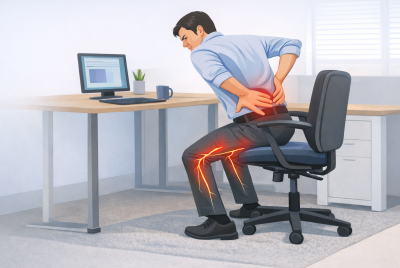Ankle Pain from Sciatica
Discover how to alleviate ankle pain from sciatica with effective treatments and preventive measures. Find relief and regain mobility today! Ankle pain from sciatica can be a challenging and debilitating condition that affects many individuals. As someone who has dealt with the discomfort and frustration of this pain, I understand firsthand the impact it can have on daily life. In this article, I’ll delve into the intricacies of this condition, offering insights, suggestions, and reasons for seeking proper care and management.
Introduction
Sciatica is a term used to describe pain that radiates along the path of the sciatic nerve, which branches from your lower back through your hips and buttocks and down each leg. When this nerve becomes compressed or irritated, it can lead to a variety of symptoms, including pain, numbness, and tingling sensations. One common manifestation of sciatica is ankle pain, which can significantly impair mobility and quality of life.
Understanding the Connection Between Sciatica and Ankle Pain
The sciatic nerve is one of the longest nerves in the body, extending from the lower back down to the feet. When it becomes inflamed or compressed, it can send shooting pain signals down the leg, often reaching as far as the ankle. This pain is typically described as sharp, stabbing, or electric shock-like and may worsen with movement or prolonged sitting.
Additionally, sciatica can indirectly affect the ankle by causing muscle weakness or imbalance in the leg, leading to instability and an increased risk of injury. The constant strain on the ankle joints and muscles can exacerbate existing pain and inflammation, creating a cycle of discomfort and dysfunction.
Symptoms of Ankle Pain from Sciatica
Ankle pain resulting from sciatica may present itself in various ways, including:
- Shooting pain that travels from the lower back to the ankle
- Tingling or numbness sensation in the ankle or foot
- Weakness or instability in the ankle joint
- Difficulty bearing weight or walking without discomfort
These symptoms can vary in intensity and frequency depending on the underlying cause and severity of the nerve compression.
Diagnosis and Assessment
Proper diagnosis of ankle pain from sciatica requires a comprehensive evaluation by a healthcare professional. This typically involves a thorough physical examination to assess reflexes, muscle strength, and sensation in the affected leg and ankle. Imaging tests such as MRI or X-ray may also be ordered to visualize the spine and identify any structural abnormalities or nerve compression.
Treatment Options
Treatment for ankle pain from sciatica focuses on relieving symptoms, reducing inflammation, and addressing the underlying cause of nerve compression. Depending on the severity of the condition, treatment options may include:
- Pain management techniques such as hot or cold therapy and transcutaneous electrical nerve stimulation (TENS)
- Physical therapy exercises to improve strength, flexibility, and posture
- Medications such as nonsteroidal anti-inflammatory drugs (NSAIDs) or muscle relaxants to alleviate pain and muscle spasms
- Injection therapy, including corticosteroids or nerve blocks, to target inflammation and provide temporary relief
- Surgery may be considered in cases of severe or persistent nerve compression that does not respond to conservative treatments.
Preventive Measures
While some risk factors for sciatica and ankle pain, such as age and genetics, are beyond our control, there are steps we can take to reduce the likelihood of developing or exacerbating these conditions:
- Maintaining good posture and ergonomics, especially when sitting or standing for extended periods
- Incorporating regular exercise into your routine to strengthen the core muscles and support spinal health
- Maintaining a healthy weight to reduce pressure on the spine and nerves
- Avoiding activities or movements that strain the lower back or exacerbate symptoms
Home Remedies for Ankle Pain Relief
In addition to medical treatments, there are several home remedies and self-care techniques that can help alleviate ankle pain associated with sciatica:
- Resting and elevating the affected leg to reduce swelling and pressure on the nerve
- Applying ice or heat packs to the ankle to numb pain and reduce inflammation
- Performing gentle stretching exercises to improve flexibility and relieve tension in the muscles surrounding the sciatic nerve
- Taking over-the-counter pain relievers such as ibuprofen or acetaminophen to manage discomfort and inflammation
The Importance of Seeking Professional Help
While self-care measures and home remedies can provide temporary relief, seeking professional medical attention is essential if you experience persistent or worsening symptoms. A healthcare provider can conduct a thorough evaluation, determine the underlying cause of your ankle pain, and recommend appropriate treatment options tailored to your specific needs.
Early intervention is crucial for preventing further damage and improving long-term outcomes. Attempting to self-diagnose or self-treat sciatica-related ankle pain without professional guidance can lead to delays in care and potentially exacerbate the condition.
Living with Sciatica and Ankle Pain
Living with this pain can be challenging, but it’s essential to focus on self-care and seek support from healthcare professionals and loved ones. Coping strategies such as mindfulness techniques, relaxation exercises, and gentle physical activity can help manage pain and improve overall well-being. Additionally, joining support groups or seeking counseling can provide emotional support and practical advice for navigating the challenges of living with chronic pain.
When to See a Doctor
While many cases of sciatica-related ankle pain resolve with conservative treatments, there are instances where medical intervention may be necessary. It’s essential to consult a healthcare provider if you experience any of the following symptoms:
- Persistent or severe pain that does not improve with rest or over-the-counter medications
- Difficulty walking or standing due to weakness or instability in the ankle
- Loss of bladder or bowel control, which may indicate a more serious underlying condition such as cauda equina syndrome
Prompt medical attention is crucial for preventing complications and ensuring proper management of sciatica-related ankle pain.
My Personal Experience with Ankle Pain from Sciatica
As someone who has experienced the debilitating effects of sciatica-related ankle pain, I can empathize with the physical and emotional toll it can take. From the constant discomfort and limited mobility to the frustration of trying various treatments without success, I understand the challenges firsthand. However, I’ve also learned the importance of seeking professional help, following a comprehensive treatment plan, and incorporating self-care strategies into my daily routine. While living with sciatica and ankle pain may present its challenges, it’s essential to remain proactive in managing symptoms and maintaining overall well-being.
Frequently Asked Questions (FAQs)
Can ankle pain be the only symptom of sciatica?
While ankle pain can be a prominent symptom of sciatica, it is often accompanied by other manifestations such as leg pain, numbness, or weakness.
Is surgery the only option for treating ankle pain from sciatica?
Surgery is typically considered a last resort when conservative treatments fail to provide relief. Many individuals find success with non-invasive therapies such as physical therapy, medication, and injection therapy.
Can sciatica-related ankle pain improve over time?
Many people experience significant improvement in their symptoms over time with proper treatment and self-care. However, the effectiveness of treatment may vary depending on the underlying cause and severity of the condition.
Are there specific exercises I can do to alleviate ankle pain from sciatica?
Yes, gentle stretching and strengthening exercises targeted at the muscles surrounding the sciatic nerve can help alleviate ankle pain and improve mobility. However, it’s essential to consult a healthcare professional before starting any new exercise regimen.
How long does it take to recover from ankle pain caused by sciatica?
The recovery time varies depending on the individual’s condition, the severity of symptoms, and the effectiveness of treatment. While some people may experience relief within a few weeks or months, others may require more extended periods of care and rehabilitation.
Ankle Pain from Sciatica – Conclusion
Ankle pain from sciatica is a complex and often challenging condition that requires careful evaluation and management. By understanding the underlying causes, symptoms, and treatment options, individuals can take proactive steps to alleviate discomfort, improve mobility, and enhance their quality of life. Whether through conservative treatments, medical interventions, or self-care strategies, it’s essential to seek professional guidance and support to manage sciatica-related ankle pain effectively.
Disclaimer
This article is for informational purposes only and is not a substitute for professional medical advice, diagnosis, or treatment. Always consult with your healthcare provider before starting a new exercise or stretching routine, especially if you have existing back or nerve conditions.
👉 Explore more:





